West Coast University, NURS 100 Quiz 1 - Study Guide,100% CORRECT
Document Content and Description Below
West Coast University, NURS 100 Quiz 1 - Study Guide 1. Communication is the means to establish helping-trust relationships. 2. Need to find 3. Nursing diagnosis is Impaired Verbal Communication an... d could be due to: 1. Inability to articulate words 2. Inappropriate verbalization 3. Difficulty forming words 4. Difficulty comprehending 4. If patients cannot speak clearly use letter board, flash cards etc, a. If Cognitive impairment: use family and friends in conversations also use pictures or gestures b. Patients who are hearing impaired: reduce environmental noise, face patients with mouth visible, use sign-language interpreter if indicated. c. Visually impaired Use 14 point font +, Identify yourself when you enter room and when you leave. d. If they don’t speak English use communication board, pictures, cards, interpreter. 5. Aspects of Professional Communication are: a. Appearance, Courtesy, Use of Names, Autonomy and responsibility, Assertiveness, Trustworthiness. 6. The qualities, behaviors and communication techniques that affect professional communication are a. Active listening, Therapeutic communication, SOLER, Sharing Observations, b. Sharing empath, hope, humor, feelings. c. Using silence, providing info, clarifying, paraphrasing, validation, asking relevant questions. d. Therapeutic Communication Techniques: are specific responses that encourage the expression of feelings and ideas and convey acceptance and respect. e. Active listening: being attentive to what a patient is saying both verbally and nonverbally. i. Use SOLER acronym 1. S: sit facing the patient 2. O: open position (arms and legs uncrossed) 3. L: Lean toward a patient 4. E: Eye contact, 5. R: Relax ii. Sharing Observations: commenting on how the person looks, sounds or acts. ( someone who didn’t eat their food “ I see you haven’t eaten anything”) iii. Sharing Empathy: being able to be empathic with patients (ability to understand and accept another person’s reality, accurately perceive feelings and communicate this understanding to the patient) iv. Sharing Hope: hope is an essential part of healing. v. Sharing Humor: helps relieve stress, tension, anxiety and worry. It also increases interpersonal communication by making the nurse seem more caring, warm and approachable. vi. Sharing Feelings: it is okay to share feeling with patients and increased the interpersonal communication. However, do not allow the emotions to become uncontrolled or cause the patient distress/ break confidentiality. 1. Avoid expressing anger/sadness. vii. Using Touch: can convey affection, emotional support, encouragement, tenderness, and personal attention. 1. It is important to know when touch is appropriate and you should always ask before you touch. viii. Using Silence: If silence is initiated let the patient break the silence this gives you time to think ix. Clarifying: it is always important to clarify an ambiguous statement made by a patient. x. Focusing: this is a way to redirect the conversation to more effective topics xi. Validation: You want to let the patient know that you have heard their concerns, feelings, and thoughts. 1. “Tell me if I understand you are worried about…..” xii. Asking Relevant Questions: These questions are needed to allow a nurse to make a decision about a patient 1. Try to avoid asking to many questions as it is dehumanizing. xiii. Summarizing: reviews the key aspects of a conversation and reminds patients of what was spoken about before. xiv. Self Disclosure: Try to find common ground with a patient sympathize with them. xv. Confrontation: is when you help someone understand they are being inconsistence with their feelings, attitudes, beliefs and behaviors. Territoriality and Personal Space: is the need to maintain and defend ones right to space. xvi. When personal space becomes threatened people respond defensively and communicate less effectively. f. Zones of personal Space i. Intimate Zone is 0-8’ 1. Holding a crying infant 2. Performing physical assessment 3. Bathing, grooming, dressing, feeding, and toileting a patient 4. Changing a patients surgical dressing ii. Personal zone is 18inches to 4ft 1. Sitting at a patient’s bedside 2. Taking a patient’s nursing history 3. Teaching an individual patient iii. Socio-Consultative Zone 9 to 12 feet 1. Giving directions to visitors 2. Asking if families need assistance from the patient door way 3. Giving a verbal report to a group of nurses iv. Public zone 12+ feet 1. Speaking at a community forum 2. Lecturing a class of students 3. Testifying at a legislative hearing g. Special zones of touch i. Social zone (permission not needed) 1. Hands, arms, shoulders, back ii. Consent zone (Permission needed) 1. Mouth, wrists, feet iii. Vulnerable Zone 1. Face, neck, front of body iv. Intimate zone 1. Genitalia, rectum Vital Signs 1. Normal Vital Signs: i. Temp: 36-38C (98.6-100.4F) ii. Oral: 37C/98.6F iii. Rectal 37.5C/99.5F iv. Axillary 36.5C/97.7F b. Pulse 60-100BPM, Strong/regular c. Oximetry 95%+ d. Respirations Adult: 12-20 Breaths/min e. BP: 120/80, Pulse pressure 30-50mm hg (difference between systolic/diastolic) f. CO2 35-45mm hg 2. Factors that cause changes in Vital signs a. Age (infants 95.9-99.5) older adults 95-97 b. Exercise increases body temp c. Hormone levels (women fluctuate more than men) d. Circadian Rhythm (Lowest between 1-4am) e. Environment f. Stress g. Temperature Alterations 3. Ranges for Infant, Child, Adult a. HR: Infant 120-160, Child 75-100, Adult 60-100 b. Respiratory Rate: Infant 30-50, Child 20-30, Adult 12-20 c. BP: infant 65-115/42-80 mm Hg, Child 87-117/48-64 mm Hg, Adult 120/80 4. When to take vital signs a. On admission b. When assessing patient during home care visit c. In hospital on their schedule, before, during, after surgery or, i. Transfusion of blood ii. Administration of meds iii. Nursing intervention d. When patient general condition changes e. When patient reports not specific symptoms 5. NEED TO FIND Infection Control 1. Chain of infection and disruption. a. An infectious agent or pathogen, (WASH HANDS can use antibacterial/fungal, bactericidal agents) b. A reservoir or source for pathogen growth (can use pesticides and bactericidal agent) c. Port of exit (use standard, contact and droplet) precautions to prevent spread. d. Mode of Transmission (Wash hands, and equipment to prevent transmission) e. Portal of entry ( need to cover lesions, cuts, scrapes, eyes, mucous membranes to avoid getting HEP B) f. Susceptible host (Isolate host and ensure proper PPE and hand hygiene is completed) 2. Normal Body defenses against infection a. Normal flora located on skin prevent growth of other bacteria b. Mucous membranes are moist and have cilia to remove bacteria c. Inflammation (vasodilation, increased WBC to site{neutrophils and monocytes) i. Leukocytosis 3. Patients most at risk for infection are; a. Immunocompromised b. Older adults c. Chronic diseases (COPD, Heart Failure, diabetes) d. Nutritional Status e. Stress f. Disease process (ppl with aids, leukemia, aplastic anemia) 4. Conditions that promote the transmission of HAI are: a. Urinary Tract i. Unsterile insertion of urinary catheter ii. Improper positioning of the drainage tubing iii. Open drainage system iv. Improper perineal hygiene v. Improper specimen collection technique b. Surgical/Traumatic Wounds i. Improper skin preparation before surgery ii. Failure to clean skin surface properly iii. Failure to use aseptic technique during operative procedures and dressing iv. Using contaminated antiseptic solutions c. Respiratory Tract i. Contaminated respiratory equipment ii. Failure to use aseptic technique while suctioning airway iii. Improper disposal of secretions d. Bloodstream i. Contamination of IV fluids by tubing ii. Insertion of drug additives to IV fluid iii. Improper care of needle insertion site. iv. Contaminated needles 5. Local vs Systemic Signs of Infection a. Localized: Patient usually experiences i. Pain, tenderness, warmth, redness at the wound site b. Systemic i. Increased body temp, HR, WBC count, pain in systems/regions away from original site 6. Medical vs Surgical Asepsis a. Medical Asepsis: Hand hygiene, barrier techniques, and routine environmental cleaning i. Includes procedures for reducing the # of organisms present and preventing the transfer of organisms b. Surgical asepsis: Prevents contamination of an open wound, serves to isolate the operative area from the unsterile environment and maintains a sterile field for surgery. i. Procedures used to eliminate all microoganisms including pathogens and spores from object or area. 7. Rational of standard precautions a. To prevent and control infection and its spread i. Provide patients and healthcare workers protection against infections.. 8. Infection and Control intervention differences Home VS hospital a. In a home setting you do not have access to all the tools that are available in the hospital b. FIND OUT MOER INFO 9. Isolation Procedures for Each Category a. Airborne i. infection isolation: Negative airflow that is filtered through a HEPA filter. ii. Must also wear a N95 respirator/mask b. Droplet i. Wearing a surgical mask when within 3 feet of patient, proper hand hygiene and face protection c. Contact i. Require gown and gloves and proper hand hygiene d. Protective environment i. Focuses on limited patient population ii. Requires positive airflow room and patient must wear mask when out of their rooms 10. The difference between occupational exposure and post-exposure process a. FIND INFO 11. Occupational exposure is: a person working in an environment with one or more risk factors present. 12. Post-exposure process: a. PEP), is any preventive medical treatment started immediately after exposure to a pathogen (such as a disease-causing virus), in order to prevent infection by the pathogen and the development of disease. Physical Assessment Mobility and Immobility 1. The functions of the skeletal systems and nervous systems in regulate on of movement o Skeletal: The skeletal system provides attachments for muscles and ligaments and leverage necessary for mobility. o Nervous: Regulates movement and posture. ▪ Precentral gyrus aka motor strip is a major voluntary motor area 2. Physiological and pathological influences on body alignment and joint mobility o Physiological: Postural Abnormalities, Muscle Abnormalities, Damage to CNS, Direct Trauma to the musculoskeletal System ▪ Postural: Affect the efficiency of musculoskeletal system and body alignment, balance, and appearance. ▪ Muscle Abnormalities: alterations in musculoskeletal function, muscular dystrophies cause degeneration of skeletal muscular fibers ▪ Damage to CNS: dmg to any component of the CNS that regulates voluntary movements results in impaired body alignment, balance, and mobility. • Trauma to the head or anything that damage the motor strip in cerebellum will cause impairment ▪ Direct Trauma: Results in bruises contusions sprains and fractures. • Can occur as an external trauma or consequence of some deformity of the bone. 3. Psychosocial / Physiological influences on body alignment and joints o Psychosocial: Immobility can cause patients to become depressed because they can no longer complete ADL’s ▪ May begin to feel loneliness, isolation, sadness. o Physiological: ?? 4. Elements of an assessment of body alignment and mobility o Range of Motion: maximum amount of movement available at a joint in one of three planes ▪ Sagittal, transverse or frontal o Gait: style of walking ▪ Observe patient speed stride and balance when entering a room ▪ Ask them to walk across room turn and comeback ▪ Ask them to walk heel to toe in straight line o Exercise and activity tolerance: ▪ Exercise: Physical activity for conditioning the body ▪ Activity tolerance: the type and amount of exercise or work a person is able to perform without undue exertion or possible injury • Is used to plan activity such as walking, ROM exercises and ADL’s. o Body Alignment: ▪ Determine normal physiological changes in body alignment due to growth and development ▪ Identify deviations in body alignment caused by incorrect posture ▪ Provide opportunities for patients to observe their posture ▪ Identify learning needs for patient to maintain correct body alignment ▪ Identify trauma, muscle damage or nerve dysfunction ▪ Obtain info on other factors contributing to incorrect alignment. • Fatigue, malnutrition and psychological problems 5. Appropriate nursing diagnoses for patients with impaired mobility o Two Types of Nursing Diagnoses: impaired physical mobility, Risk for disuse Syndrome ▪ Impaired physical mobility: patient has some limitation but is not completely immobile ▪ Risk for Disuse syndrome: Patient is immobile and risk for multisystem problems due to inactivity. 6. Active and passive range of motion Exercises: o Active ROM exercises are when the patient completes the range of motion (can still be limited but not immobile) o Passive ROM is when you carry out the movement for the patient ▪ Should never force a joint beyond its capacity (should be smooth and slow to point of resistance) 7. Importance of no-lift policies (CANT FIND) 8. Equipment needed for safe patient transfer and movement: o IN BED: ▪ Pillows, drawsheet ▪ Therapeutic boots, splints if needed ▪ Trochanter roll: prevents external rotation of hips when pt is in supine position ▪ Trapeze bar: triangular device hanging down from overhead • Allows patient to pull with upper extremities to raise truck off bed, transfer from bed to wheelchair, upper arm exercise ▪ Hand rolls ▪ Side rails ▪ Appropriate safe patient-handling assistive device 9. Evaluation of nursing care for maintaining body alignment and mobility: o Evaluate effectiveness of specific interventions designed to promote body alignment, improve mobility, and protect patient from hazards of immobility. o Did patient improve body alignment, joint mobility, walking, moving or transferring as designed in the care plan? Hygiene 1. Factors influencing personal hygiene practices: a. Social practices: Influence hygiene preferences and practices including the type of hygiene products used and frequency of personal care pratices b. Personal preferences: patients have individual preferences about when and how to perform hygiene and grooming care c. Body Image: Subjective concept of his or her body including physical appearance, structure, or function i. Body image affects way in which individuals maintain personal hygiene d. Socioeconomic status: persons economic resources influence type and extent of hygiene practices used. e. Health Beliefs and Motivation: Knowledge about importance of hygiene and its implication for well-being influence hygiene practices f. Cultural variables: Beliefs and personal values influence hygiene care g. Developmental stages: normal process of ageing affects the condition of body tissue and structure i. Skin Children and older adults have fragile skin ii. Feet and nails, as people age more likely to develop chronic foot problems 1. People with diabetes and rheumatoid arthritis have painful feet. iii. Mouth 6-8months first teething, 6 yrs old permanent teeth. 1. Diabetes and disabilities involving grasp affect oral hygiene care iv. Hair v. Eyes ear and nose h. Physical condition: Patients with certain types of physical limitations or disabilities lack energy and dexterity to perform hygiene care i. IV, Cast, arthritis stroke, muscular disorders: require help with hygiene 2. Implications of inadequate hygiene practices. a. Oral: patient lacks upper extremity strength or dexterity needed to brush teeth i. Dehydration causes drying and fragility of mucosa, also increases accumulation of secretions on tounge/gums ii. Tubes cause pressure friction and drying b. Skin: Dependent body parts are exposed to pressure from underlying surfaces. Inability to change position/turn increases risk for pressure ulcers i. Obesity: patient cannot see skin properly/clean it ii. Reduced sensation: patient can not feel pain, hot, cold, chemical irritants iii. Cognition issues: patient cannot verbalize skin care needs. iv. Excessive secretions: increases bacterial growth causes local irritation v. Vascular insufficiency: blood supply to tissues is impaired tissue breakdown causes high risk for infection c. Foot: Patient unable to bend over to visually inspect foot d. Eye: Physical limitations create inability to safely insert or remove contact lenses i. Reduced dexterity and hand coordination. 3. Common Hair/Scalp Problems and interventions a. Dandruff: scaling of scalp with itching i. Shampoo with medicated shampoo b. Ticks: parasites burrow into skin and suck blood i. Use blunt tweezers and grasp tick, pull upward with steady pressure hold tick until pulls out (3-4min) freeze tick if need to ID c. Pediculosis (lice)/ Pediculosis Capitis (head lice) i. Parasite resides on scalp attached to hair, looks like dandruff (eggs) bites may be visible behind ears/hairline 1. Use gloves, check scalp using lice comb, medicated shampoo for lice, 2. Manual removal best when treatment failed 3. Vacuum infested home area’s d. Pediculosis Corporis (body lice) i. Bathe or shower thoroughly, after skin dries apply pediculicide lotion. ii. 12-24 hours later take 2nd bath/shower. iii. Bag infected clothing and wash with hot water. e. Hair Loss (alopecia) i. Stop hair care practices that damage hair 1. Hygiene care for older adult, younger patient, impaired patient, how they differ Pain management 1. Nature of pain a. Involves physical, emotional, cognitive components b. Results from physical and or mental stimulation c. Reduces quality of life d. Not measurable objectively e. Is subjective and highly individualized component 2. Physiology of Pain a. Impulses ascend the spinal cord to the thalamus which transmits info to higher brain centers that perceive pain i. Two types of sensory nerve fibers: 1. A-delta fast myelinated send sharp localized, distinct sensations 2. C fibers are unmyelinated and send poorly localized burning, persistent pain. ii. Transduction: Conversion of stimulus into electrical energy iii. Transmission: Sending of impulse across a sensory pain never fiber iv. Perception: The patients experience of pain v. Modulation: inhibition of pain/release inhibitory neurotransmitters b. Gate Control Theory of pain: i. Pain has emotional and cognitive components in addition to physical sensation ii. Gating mechanisms in CNS regulate or block pain impulses iii. Pain passes through when gate is open and blocked when its closes iv. Closing gate is the basis for nonpharmacological pain relief interventions 3. Types of Pain: a. Acute/transient pain: protective identifiable short duration limited emotional response b. Chronic/persistent non cancer: Is not protective has no purpose may or may not have an identifiable cause c. Chronic episodic: Occurs sporadically over an extended duration d. Cancer: Can be acute or chronic e. Inferred pathological: Musculoskeletal visceral, or neuropathic f. Idiopathic: Chronic pain without identifiable physical or psychological cause 4. Factors influencing Pain: a. Physiological: Age, fatigue, genes, neurological function b. Social: attention, previous experiences family and support groups, spiritual c. Psychological: anxiety coping style d. Pain Tolerance: lvl of pain a person willing to accept e. Cultural: Meaning of pain and ethnicity 5. Nursing Process and Pain a. Pain management needs to be systematic b. Needs to consider the patients quality of life 6. Assessment: Patients expression of pain a. Characteristics of pain i. Onsent/duration ii. Location iii. Intensity iv. Quality v. Pattern vi. Relief measures vii. Contributing symptoms viii. Effects of pain on the patient. 7. Nursing Diagnosis a. Activity intolerance b. Anxiety c. Ineffective coping d. Fatigue e. Hopelessness f. Insomnia g. Fear h. Impaired physical mobility i. Powerlessness j. Chronic low self-esteem k. Impaired social interaction l. Spiritual distress m. Imbalanced nutrition: less than body requirements 8. Planning: determine with the patient what the pain has prevented the patient from doing a. Agree on acceptable lvl of pain that allows return of function 9. Implementation: Health promotion a. Nonpharmacological pain relief interventions i. Relaxation, guided imagery ii. Biofeedback: iii. Distraction/music iv. Cutaneous stimulation (TENS, heat, cold, acupressure) v. Herbals vi. Reducing pain perception b. Pharmacological pain relief i. Acute pain management with use of 1. Analgesics a. Non-opioids b. Opioids c. Adjuvants/co-analgesics 2. Delivery systems a. PCA (patient controlled analgesia) b. Local/regional anesthesia c. Topical agents 10. Chronic Noncancer and Cancer Pain Management a. Breakthrough pain: Transient flare of moderate to severe pain superimposed on continuous or persistent pain. b. Transdermal pain patches may be used 11. Communication Checklist (what to ask leaving nurse) a. What is pain right-now over the past XX of time b. Which pain rating is acceptable to the patient c. How do you recommend that the patients treatment be changed to reduce the pain rating d. Which professional reference can be used if needed, to support this recommendation [Show More]
Last updated: 1 year ago
Preview 1 out of 13 pages

Reviews( 0 )
Recommended For You
*NURSING> EXAM > NURS MISCNCLEX Exam 2_Study Guide,100% CORRECT (All)
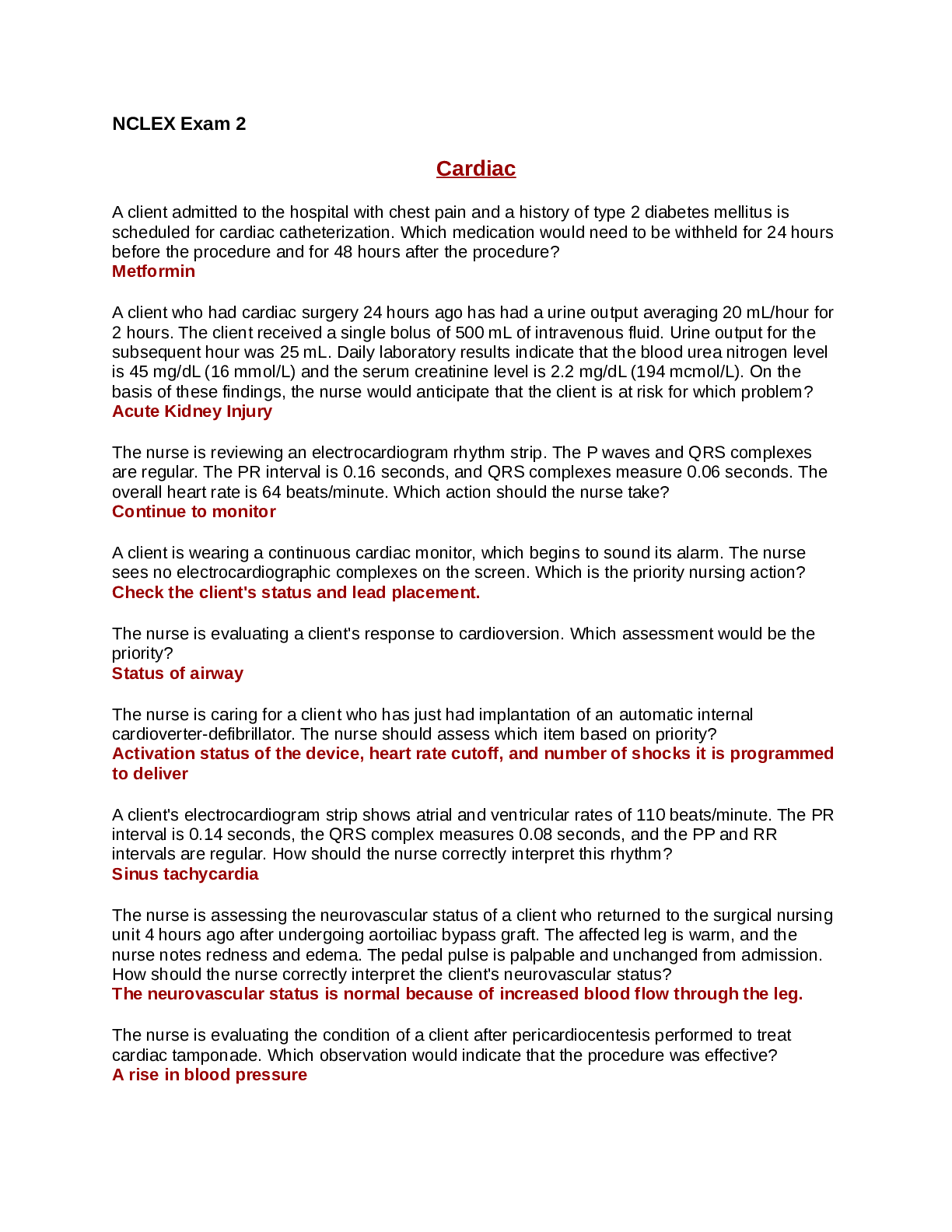
NURS MISCNCLEX Exam 2_Study Guide,100% CORRECT
NURS MISCNCLEX Exam 2_Study Guide NCLEX Exam 2 Cardiac A client admitted to the hospital with chest pain and a history of type 2 diabetes mellitus is scheduled for cardiac c...
By Nolan19 , Uploaded: Jan 05, 2022
$15
*NURSING> EXAM > Nurs 6501 Quiz 1 -Advanced Pathophysiology-Walden University 2022 (100% solved questions) (All)

Nurs 6501 Quiz 1 -Advanced Pathophysiology-Walden University 2022 (100% solved questions)
Nurs 6501 Quiz 1 -Advanced Pathophysiology-Walden University 2022 (100% solved questions) A runner has depleted all the oxygen available for muscle energy. Which of the following will facilitate...
By MARKALLAN , Uploaded: Jul 30, 2022
$8
Health Care> EXAM > NSG 6020 Week 8 Quiz 1 - Question and Answers_ latest 2020 (answered) (All)

NSG 6020 Week 8 Quiz 1 - Question and Answers_ latest 2020 (answered)
NSG 6020 Week 8 Quiz 1 A 14-year-old junior high school student is brought in by his mother and father because he seems to be developing breasts. The mother is upset because she read on the Inte...
By Crum , Uploaded: Jul 16, 2022
$13
*NURSING> EXAM > NURS 4325 Research Quiz 1 -with 100% verified answers 2022 (All)

NURS 4325 Research Quiz 1 -with 100% verified answers 2022
• Question 1 Which of the following study designs focuses on finding a cause and effect relationship among variables, but uses a lower level of control? Selected Answer: quasi-experimental Cor...
By Studyrepository , Uploaded: Jul 10, 2022
$10.5
*NURSING> EXAM > NURS 6541 Week 6 Quiz 1 - Question and Answers (All)
.png)
NURS 6541 Week 6 Quiz 1 - Question and Answers
1. A 3-year-old has a history of upper respiratory tract infection 2 weeks ago. She recently started awakening at night. Physical exam reveals a normothermic child. She is smiling, playful, and sittin...
By QuizBank , Uploaded: Jul 09, 2022
$7
*NURSING> EXAM > NURS 6541 Week 5 Quiz 1 - Question and Answers (All)
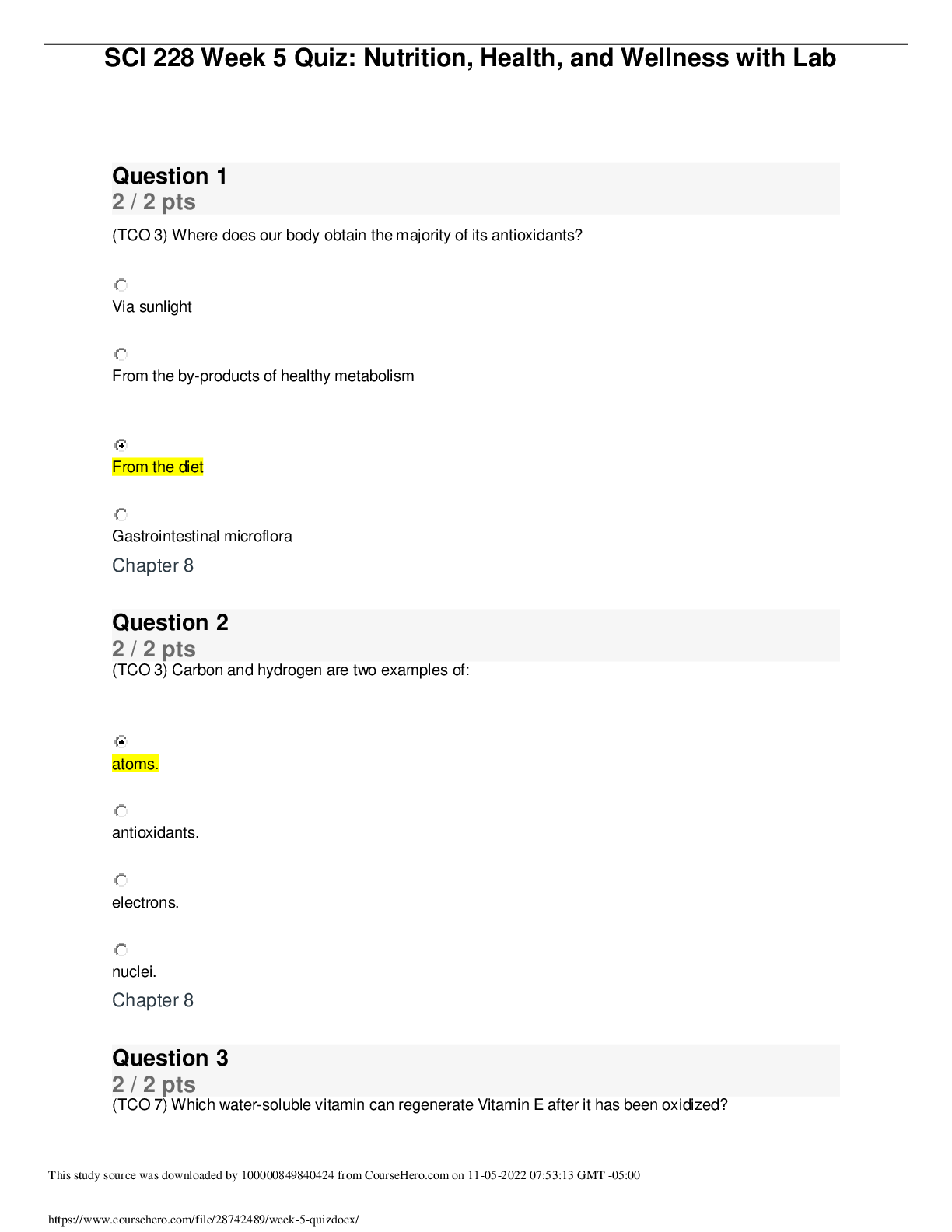
NURS 6541 Week 5 Quiz 1 - Question and Answers
1. A 7-year-old presents to your office with several linear, curved lines approximately 4 millimeters in length that end in a papule. The lines are near the umbilicus and waist area. He complains abou...
By QuizBank , Uploaded: Jul 09, 2022
$7
*NURSING> EXAM > NURS 6541 Week 2 Quiz 1 - Question and Answers (All)

NURS 6541 Week 2 Quiz 1 - Question and Answers
1. You see a healthy 18-month-old for a well-child visit. At the 12-month visit he received the diphtheria, tetanus, and acellular pertussis (DTaP) third dose; hepatitis B second dose; measles, mumps,...
By QuizBank , Uploaded: Jul 09, 2022
$7
Art> EXAM > ISYE6501 Midterm Quiz 1 | Midterm Quiz 1 -- Summer 2021 | SU21: Introduction to Analytics Modeling (All)
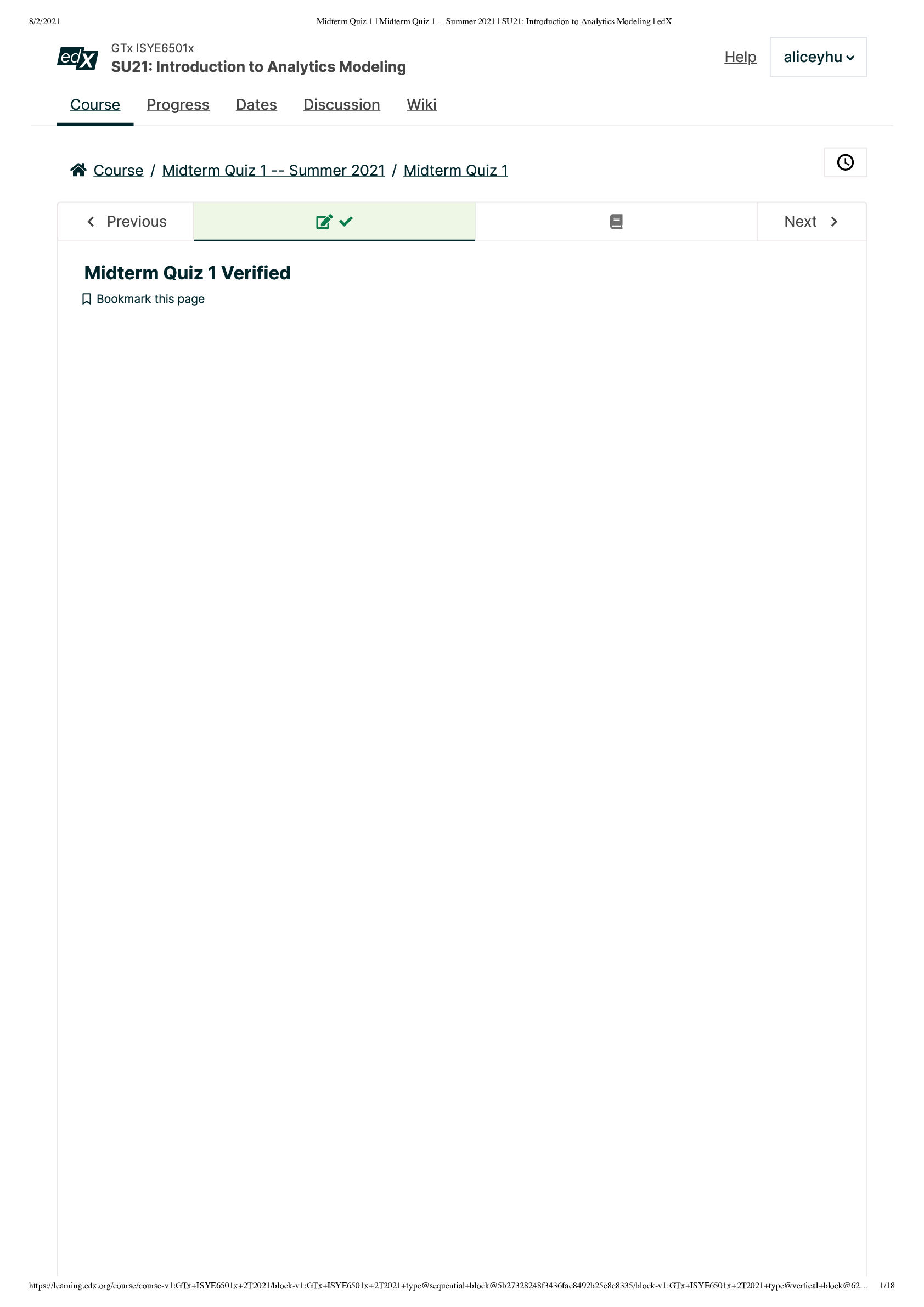
ISYE6501 Midterm Quiz 1 | Midterm Quiz 1 -- Summer 2021 | SU21: Introduction to Analytics Modeling
ISYE6501 Midterm Quiz 1 | Midterm Quiz 1 -- Summer 2021 | SU21: Introduction to Analytics Modeling
By Mariebelle , Uploaded: Jul 08, 2022
$9
Engineering> EXAM > ISYE 6501 Midterm Quiz 1 - GT Students Launch Proctortrack first before taking the Midterm Quiz 1 (All)
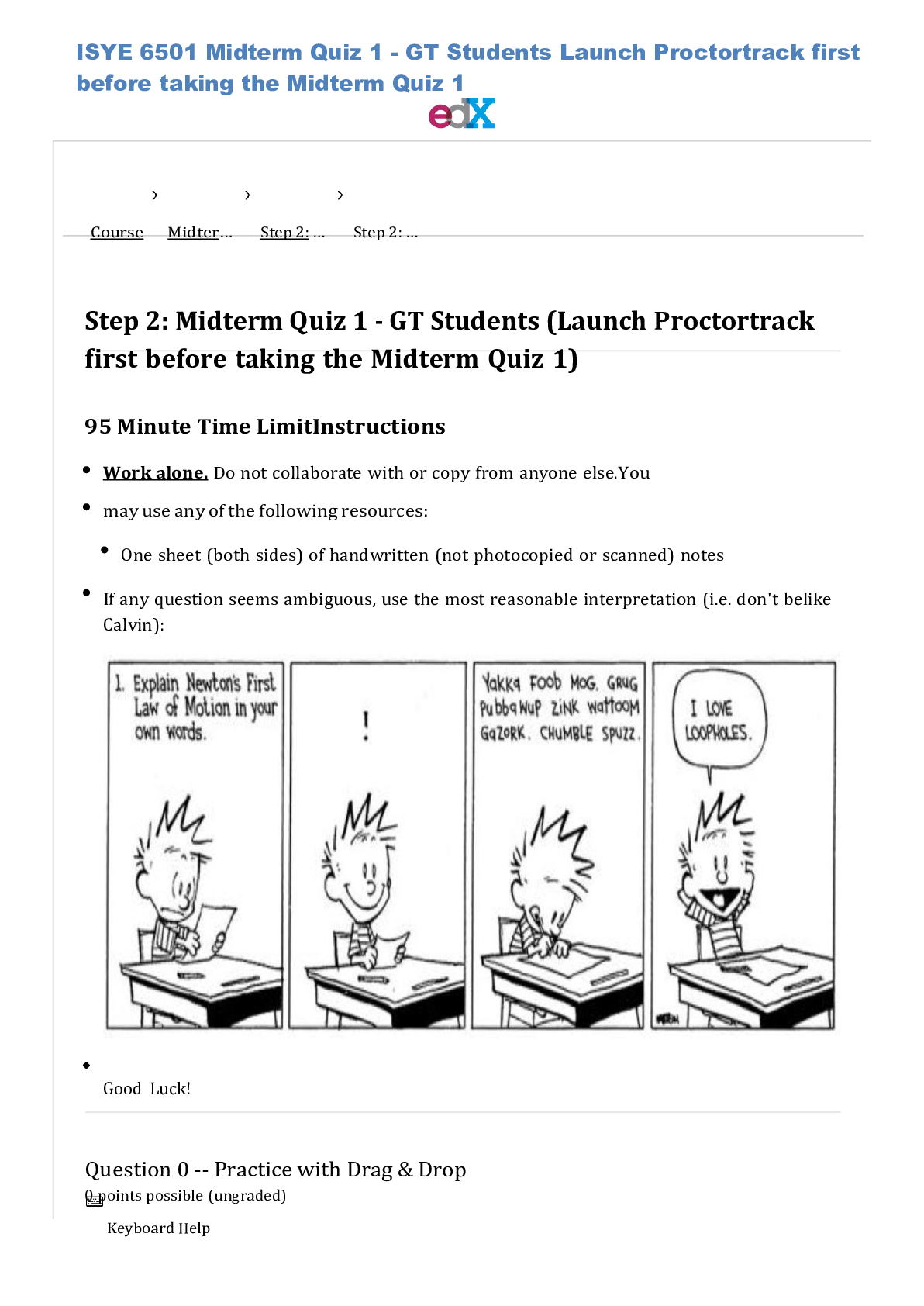
ISYE 6501 Midterm Quiz 1 - GT Students Launch Proctortrack first before taking the Midterm Quiz 1
ISYE 6501 Midterm Quiz 1 - GT Students Launch Proctortrack first before taking the Midterm Quiz 1
By Professor_Chue , Uploaded: Jun 26, 2022
$8.5
BioChemistry> EXAM > BIOCHEM 551 QUIZ 1 - LOUISIANA UNIVERSITY GRADED A+ (All)
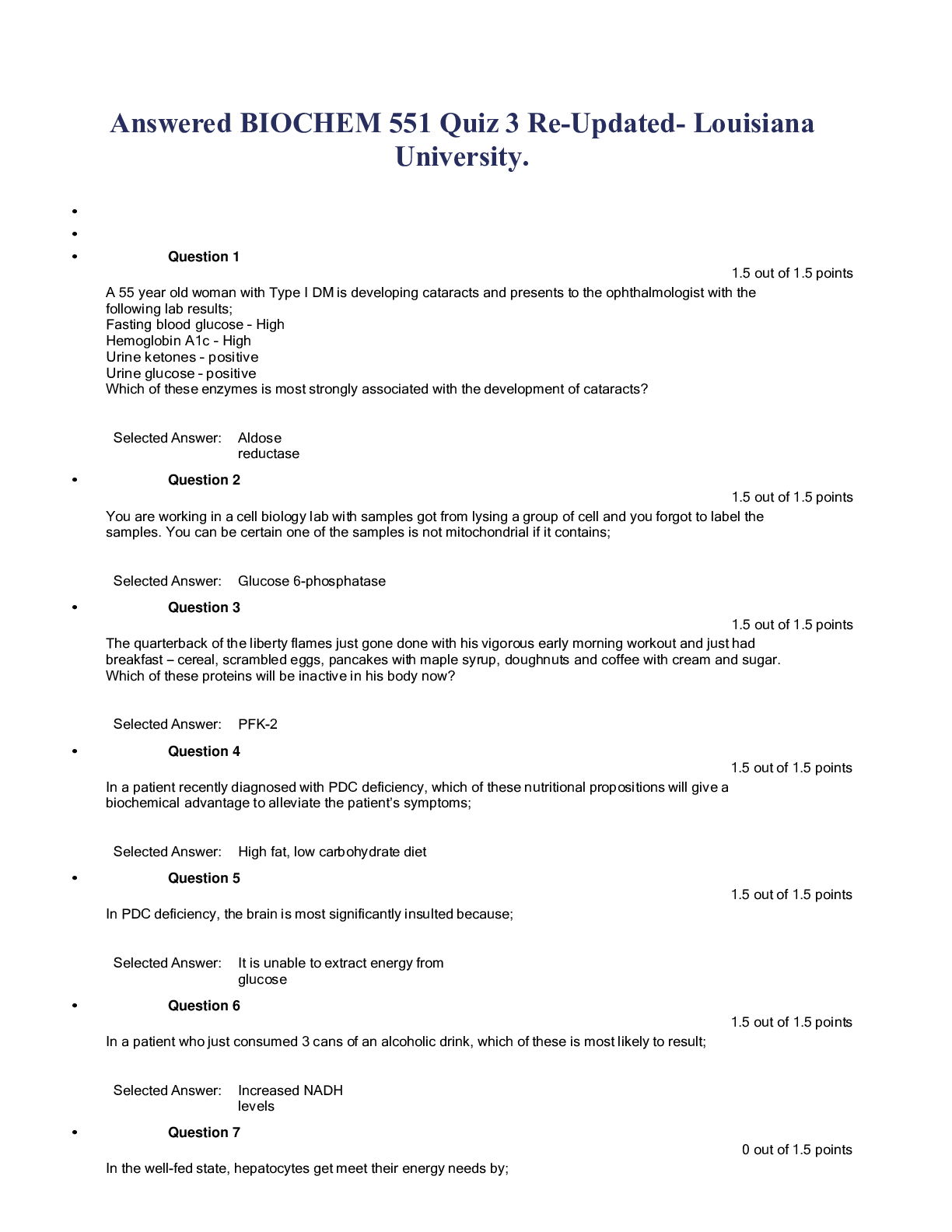
BIOCHEM 551 QUIZ 1 - LOUISIANA UNIVERSITY GRADED A+
BIOCHEM 551 QUIZ 1 - LOUISIANA UNIVERSITY GRADED A+
By MARKALLAN , Uploaded: Jun 23, 2022
$8
Document information
Connected school, study & course
About the document
Uploaded On
Mar 24, 2023
Number of pages
13
Written in
Additional information
This document has been written for:
Uploaded
Mar 24, 2023
Downloads
0
Views
36






